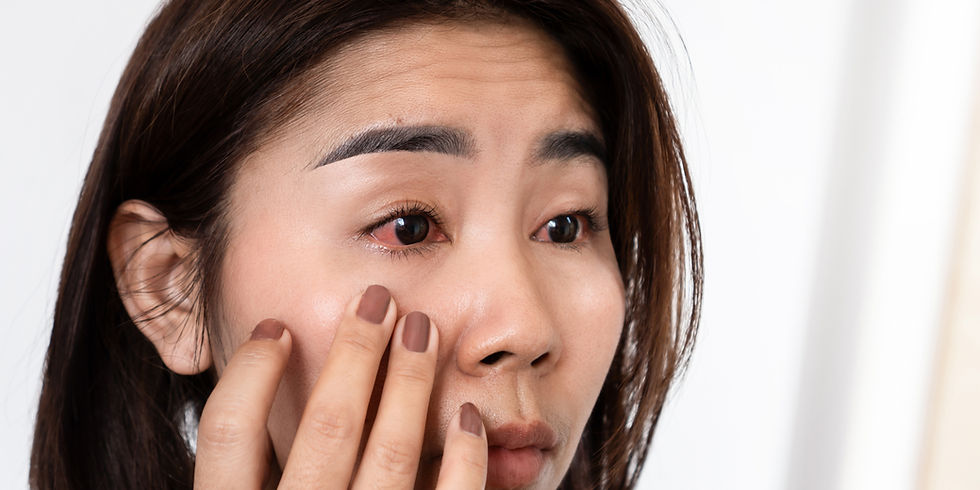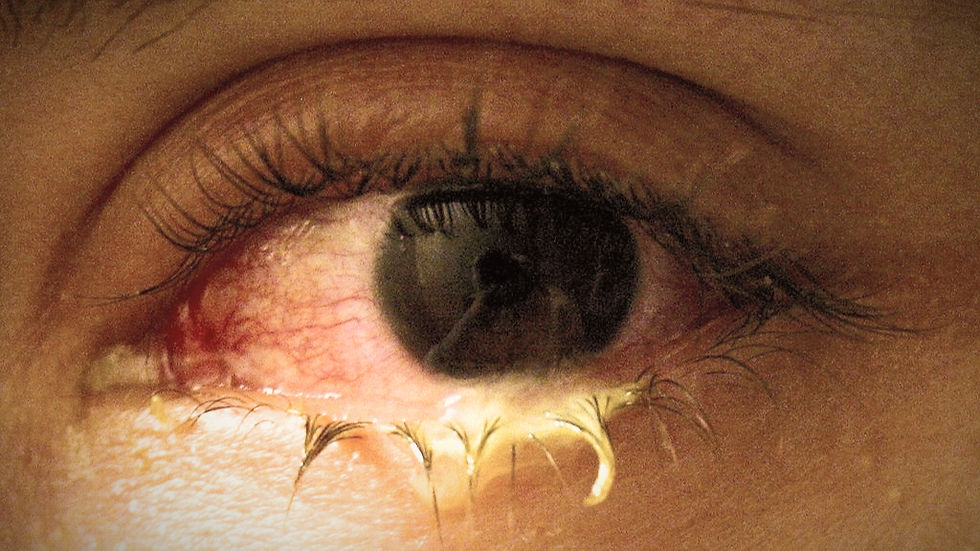Bacterial Conjunctivitis: Recognize and Manage Pink Eye
- Victoria Wermers, RN,MSN,FNP, PMHNP
- Sep 18, 2024
- 5 min read
Updated: Jul 14
This is one of those medical problems that makes parents and teachers panic because it is so contagious. Mom gets that dreaded phone call from the school nurse saying that "pink eye" is going around the classroom, so "please come pick him up." The parent complies, picks up the child, and takes him to a clinic.

Conjunctivitis is recognized by redness and irritation of the white part (sclera) of the eye and redness of the inner lids (conjunctiva). Interestingly, conjunctivitis typically does not hurt a person or have lasting effects. However, it is highly contagious. It is one of those things like colds, bronchitis, or even strep - it can go away on its own within 7-10 days. IT IS USUALLY SELF-LIMITING. But this is our "life in the fast lane" society, and while it would be wiser to let your immune system fight it off and wait it out as recommended, we don't have time. Your employer cannot give you time off, or you need the income...and the child cannot miss school for more than a day!
Viruses, bacteria, and allergies tend to be the most common causes of "pink eye," but other things like fungi and chemicals can also be causative agents. The exact cause is sometimes elusive, and a culture can be sent to the lab to determine if the problem does not respond to typical medication. Below is a brief discussion of these.
Bacterial Conjunctivitis: Recognize and Manage Pink Eye
-Symptoms
The hallmark of bacterial conjunctivitis is the nasty, purulent - often green or yellow - drainage noted in or around the eye (it is rarely clear). You wake up in the morning with your eye stuck shut - "matting," the hallmark of conjunctivitis. Bacterial conjunctivitis usually starts in one eye, and spreads to the other. Other symptoms may include:
Burning or irritation
Redness of the eye
Sensitivity to light
Gritty sensation
Swelling/redness inside the eyelids
Vision changes due to floating discharge
If you have an irritated eye(s), it is recommended that you do not rub the eye(s). Do not wear contact lenses. And, do not wear eye makeup.

-Common Causes
Contact lenses
Contact with others (especially children) or contaminated surfaces
Sinus or an ear infection (there is a physical connection between the eye, ears and sinuses. So if you have been sick with an upper respiratory problem, this may be the cause)
An eye abrasion (scratch)
Eye allergies or viruses that fester and develop secondary bacterial infections
Poor hygiene
-Management of Bacterial Conjunctivitis
Several different bacteria typically cause conjunctivitis. If you are not sure if the eye infection is bacterial (e.g., no direct contact with pink eye, if the eye drainage is clear, slight injection of the sclera), you can try to treat it symptomatically with over-the-counter drops or other methods. But don't wait too long if your eye is getting progressively worse, especially if you develop much swelling of the lid(s), fever, purulent drainage, vision problems, or much pain. You should see a healthcare provider.
Word of warning: Without an antibiotic, bacterial conjunctivitis can take two days to two weeks to go away, or it can get worse.
Note: Chlamydia and gonorrhea are sexually transmitted diseases that can also cause bacterial conjunctivitis. If you have been exposed to either one or suspect this may be a factor, be sure to mention this to a healthcare provider.
Over-the-Counter Medicines for Bacterial Conjunctivitis
There are no over-the-counter antibiotic eye drops for bacterial conjunctivitis. But some over-the-counter eye medications can help your eye(s) feel better and, possibly help the infection go away on its own. You might try one of the following:
Artificial tears (not drops for "redness")
Use a cool, moist cloth for about 15 minutes 2-3 times a day (warm may make the eye more injected or red). If treating both eyes, use a different washcloth or cool pack on each eye.
Wash outer eyelids with baby shampoo two times a day.
Ibuprofen or Tylenol over-the-counter as directed for discomfort.
There may be lots of eyedrops online that have not been studied.
Natural Remedies for Bacterial Conjunctivitis
There is not a lot of research on these.
Most of these natural remedies are applied to the outer eyelids. Most are good for soothing the irritation from the infection, but may not make conjunctivitis disappear.
Neem Leaves are used in Ayurvedic medicine (India) for conjunctivitis, so more studies are needed.
Chamomile (boiled and then cooled tea bags)
Tulsi (tea bags applied to lids; some people flush with a few drops of Tulsi tea, but it is difficult to find much research on this)
Honey eye drops (ordered online) may work as an antimicrobial and anti-inflammatory, but little recent research has been done. Follow instructions.
Calendula - Solution applied to a gauze pad and dabbed on outer eyelids
Every once in a while, a person will have a local allergic reaction to these plants. If this occurs, stop using the agent.
Conventional Prescriptive Treatment of Bacterial Conjunctivitis
This is where you go if your eye is getting nasty, thick yellow or green drainage, or if you want to convince the school nurse that your child's eye IS or IS NOT contagious.
Antibiotic eye drops are the key to this. They hasten recovery and decrease contagiousness to 24-48 hours after beginning the drops. Commonly used prescription drops include:
Azithromycin eye drops
Erythromycin eye drops
Polymyxin B/trimethoprim
Fluroquinolones - Ofloxacin, ciprofloxacin
Sulfacetamide
Things to remember if you suspect or have conjunctivitis:
Don't rub your eyes
Wash your hands often
Don't share anything that comes in contact with your face: Towels, pillows, washcloths.
Wash anything daily that comes in contact with your face.
Throw out any makeup that was in contact with your infected eye or anything that might have caused it (By the way, check the expiration dates of your facial makeup: It is pretty remarkable how soon these expire - especially the eyeliners and mascaras (how we hate to do that with expensive makeup!)
Do NOT wear contacts while you have the eye problem or are treating it (and throw out any you may have been wearing when the infection came on). " But I don't have any glasses!" Always prepare for the unexpected.
Important notes about eye drops:
Do not touch your eyelids with the dropper when instilling drops. Doing so can contaminate the drops and spread infection from one eye to another.
If you have any old eye drops at home (especially if you have been using them), be aware that there were contaminated products removed from the market several months ago. They may be contaminated. Check the list here: OTC eye drops taken off the market.
If you have any question about your eye problem(s) or treatment after reading this article, Bacterial Conjunctivitis: Recognize and Manage Pink Eye, please discuss the problem with a healthcare provider.


